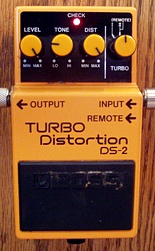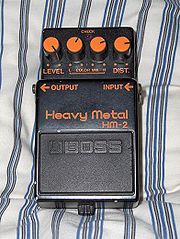
BOSS
Encyclopedia
Boss is a manufacturer of effects pedals for electric guitar
and bass guitar
. It is a division of the Roland Corporation
, a Japanese manufacturer that specializes in musical equipment and accessories. For many years Boss manufactured a range of products related to effects processing for guitars, including "compact" and "twin" effects pedals, multi-effect pedals, electronic tuner
s and pedal boards
. In more recent times, Boss expanded their products line to include Digital Studios, rhythm machines and other electronic equipment.
 The earliest Boss product was called B-100 The Boss, released in 1976. This came with a clip-on pre-amp and a pickup to amplify acoustic guitars. At this point the Boss company had not been formed and it was still technically a Roland product.
The earliest Boss product was called B-100 The Boss, released in 1976. This came with a clip-on pre-amp and a pickup to amplify acoustic guitars. At this point the Boss company had not been formed and it was still technically a Roland product.
The first proper Boss foot pedal effect, the CE-1 Chorus Ensemble, released in 1976. It was a fairly large, AC-powered unit. It was popular with artists at the time such as Andy Summers
and can be heard on various recordings.
 Boss's line of compact pedals began in 1977 with the release of three pedals: an overdrive pedal (OD-1), a phaser
Boss's line of compact pedals began in 1977 with the release of three pedals: an overdrive pedal (OD-1), a phaser
pedal (PH-1) and a parametric equalizer called the Spectrum (SP-1). The Boss DS-1
was released the next year, in 1978. Also released in this year is the T Wah (TW-1) pedal. Their first compact chorus
pedal (CE-2) came the next year (1979), and their first flanger
pedal (BF-2) in 1980. In 1983 Boss released the DD-2 Digital Delay, the first mass-produced digital delay in a compact pedal format. In 1987 Boss released nine new pedals, including the Turbo Distortion (DS-2). The Metal Zone (MT-2) was released in 1991. The Heavy Metal (HM-2) distortion pedal was an integral part of the guitar sound of many styles of heavy metal music ever since. The pedals all share the same 'footprint', for compatibility with pedal boards.
Boss introduced COSM (Composite Object Sound Modeling), Roland's proprietary version of digital modeling technology, into their AC-3 Acoustic Simulator pedal in 2006. Boss has since released several pedals using COSM, including the FBM-1 '59 Fender Bassman pedal and FDR-1 '65 Fender Deluxe Reverb pedal, introduced at the Winter NAMM show in January 2007.
All Boss compact pedals use a "buffered bypass" type of silent foot switching utilizing Field Effect Transistors (FETs) to avoid clicks and pops. While not "true" bypass, the buffered bypass has the advantage of preventing signal loss due to long runs of cable, while keeping original guitar tone intact.
The DS-1 Distortion, however, is an exception; the design has changed significantly twice throughout its lifetime. The first time was around 1994 when the Toshiba TA7136AP op-amp was replaced with the Rohm BA728N. In 2000 the op-amp was again changed. This time it was replaced with the Mitsubishi M5223AL. The latest op-amp change occurred in 2007, when new DS-1 pedals began shipping with the NJM3404AL op-amp.
In recent years older Boss compact pedals have begun to command a high premium on the used market. Some pedals, such as the relatively rare VB-2 Vibrato, SG-1 Slow Gear, SP-1 Spectrum, DC-2 Dimension C, PS-3 Digital Pitch Shifter/Delay, and either of the two analog delay pedals, the DM-2 and DM-3, are highly sought after by collectors.
The Boss Doctor Rhythm DR-110
drum machine was the last drum machine out of Roland to use analog sound synthesis to generate the drum sounds. After the DR-110, all Roland drum machines used samples of drums to produce sounds. The DR-110 is not easily incorporated into a modernized studio setup running MIDI but there are modifications available to sync the DR-110 to other gear. There are also modifications available in DIY formats to add tonal controls to the analog drum sounds on board the DR-110 that will give the user a wider range of sonic ability.
Electric guitar
An electric guitar is a guitar that uses the principle of direct electromagnetic induction to convert vibrations of its metal strings into electric audio signals. The signal generated by an electric guitar is too weak to drive a loudspeaker, so it is amplified before sending it to a loudspeaker...
and bass guitar
Bass guitar
The bass guitar is a stringed instrument played primarily with the fingers or thumb , or by using a pick....
. It is a division of the Roland Corporation
Roland Corporation
is a Japanese manufacturer of electronic musical instruments, electronic equipment and software. It was founded by Ikutaro Kakehashi in Osaka on April 18, 1972, with ¥33 million in capital. In 2005 Roland's headquarters relocated to Hamamatsu in Shizuoka Prefecture. Today it has factories in Japan,...
, a Japanese manufacturer that specializes in musical equipment and accessories. For many years Boss manufactured a range of products related to effects processing for guitars, including "compact" and "twin" effects pedals, multi-effect pedals, electronic tuner
Electronic tuner
The term electronic tuner can refer to a number of different things, depending which discipline you wish to study.In the Discipline of radio frequency electronics an electronic tuner is a device which tunes across a part of the radio frequency spectrum by the application of a voltage or appropriate...
s and pedal boards
Guitar pedalboard
A guitar pedalboard is a flat board or panel which serves as a container, patch bay and power supply for effects pedals for the electric guitar. Some pedalboards contain their own transformer and power cables, in order to power a number of different pedals. Pedalboards assist the player in...
. In more recent times, Boss expanded their products line to include Digital Studios, rhythm machines and other electronic equipment.
History

The first proper Boss foot pedal effect, the CE-1 Chorus Ensemble, released in 1976. It was a fairly large, AC-powered unit. It was popular with artists at the time such as Andy Summers
Andy Summers
Andy Summers is an English guitarist born in Poulton-le-Fylde, Lancashire, England. Best known as the guitarist for rock band The Police, he has also recorded twelve solo albums, collaborated with many other artists, toured extensively under his own name, published several books, and composed...
and can be heard on various recordings.

Phaser (effect)
A phaser is an audio signal processing technique used to filter a signal by creating a series of peaks and troughs in the frequency spectrum. The position of the peaks and troughs is typically modulated so that they vary over time, creating a sweeping effect...
pedal (PH-1) and a parametric equalizer called the Spectrum (SP-1). The Boss DS-1
Boss DS-1
The Boss DS-1 is a distortion pedal for guitar, manufactured by the Roland Corporation under the brand name Boss since 1978. The first distortion unit made by Boss, it has become a classic effect, used by many notable guitar players. Boss produced a successor, the DS-2.-Circuit design:The DS-1 has...
was released the next year, in 1978. Also released in this year is the T Wah (TW-1) pedal. Their first compact chorus
Chorus effect
In music, a chorus effect occurs when individual sounds with roughly the same timbre and nearly the same pitch converge and are perceived as one...
pedal (CE-2) came the next year (1979), and their first flanger
Flanging
Flanging is an audio effect produced by mixing two identical signals together, with one signal delayed by a small and gradually changing period, usually smaller than 20 milliseconds. This produces a swept comb filter effect: peaks and notches are produced in the resultant frequency spectrum,...
pedal (BF-2) in 1980. In 1983 Boss released the DD-2 Digital Delay, the first mass-produced digital delay in a compact pedal format. In 1987 Boss released nine new pedals, including the Turbo Distortion (DS-2). The Metal Zone (MT-2) was released in 1991. The Heavy Metal (HM-2) distortion pedal was an integral part of the guitar sound of many styles of heavy metal music ever since. The pedals all share the same 'footprint', for compatibility with pedal boards.
Boss introduced COSM (Composite Object Sound Modeling), Roland's proprietary version of digital modeling technology, into their AC-3 Acoustic Simulator pedal in 2006. Boss has since released several pedals using COSM, including the FBM-1 '59 Fender Bassman pedal and FDR-1 '65 Fender Deluxe Reverb pedal, introduced at the Winter NAMM show in January 2007.
All Boss compact pedals use a "buffered bypass" type of silent foot switching utilizing Field Effect Transistors (FETs) to avoid clicks and pops. While not "true" bypass, the buffered bypass has the advantage of preventing signal loss due to long runs of cable, while keeping original guitar tone intact.
Japan/Taiwan
Boss compact pedals were originally produced in Japan, until circa 1990 when production moved to Taiwan. Earlier units came with a metal screw securing the battery compartment, later models retained the metal screw, adding a plastic knob for tool-less battery removal. The labels on the bottom of the pedals come in several different colours including black, silver, green, pink and blue. Apart from this the basic design has remained unchanged for over 25 years.The DS-1 Distortion, however, is an exception; the design has changed significantly twice throughout its lifetime. The first time was around 1994 when the Toshiba TA7136AP op-amp was replaced with the Rohm BA728N. In 2000 the op-amp was again changed. This time it was replaced with the Mitsubishi M5223AL. The latest op-amp change occurred in 2007, when new DS-1 pedals began shipping with the NJM3404AL op-amp.
In recent years older Boss compact pedals have begun to command a high premium on the used market. Some pedals, such as the relatively rare VB-2 Vibrato, SG-1 Slow Gear, SP-1 Spectrum, DC-2 Dimension C, PS-3 Digital Pitch Shifter/Delay, and either of the two analog delay pedals, the DM-2 and DM-3, are highly sought after by collectors.
The Boss Doctor Rhythm DR-110
Boss Doctor Rhythm DR-110
The Boss Doctor Rhythm DR-110 Graphic is a drum machine, produced by the Boss product division of the Japanese Roland Corporation in 1983.Boss were better known for producing electric guitar accessories such as effects pedals, and the DR-110 is similarly small and lightweight in size , and like...
drum machine was the last drum machine out of Roland to use analog sound synthesis to generate the drum sounds. After the DR-110, all Roland drum machines used samples of drums to produce sounds. The DR-110 is not easily incorporated into a modernized studio setup running MIDI but there are modifications available to sync the DR-110 to other gear. There are also modifications available in DIY formats to add tonal controls to the analog drum sounds on board the DR-110 that will give the user a wider range of sonic ability.
See also
- Electronic tunerElectronic tunerThe term electronic tuner can refer to a number of different things, depending which discipline you wish to study.In the Discipline of radio frequency electronics an electronic tuner is a device which tunes across a part of the radio frequency spectrum by the application of a voltage or appropriate...
- Effects units
- Electric bass guitars
- List of Boss Corporation products

